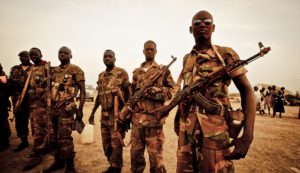South Sudan mired in civil war – again
The number of South Sudanese refugees in East Africa could reach one million by the end of the year because of renewed fighting in the civil war, the United Nations High Commissioner for Refugees (UNHCR) has warned.
Recent clashes in the capital Juba have seen fresh outflows of refugees, according to the UNHCR, which has called on armed groups to allow safe passage for people fleeing the latest fighting.
The agency has also appealed for an extra $US701 million in relief aid.
Even before the resurgence of violence recently, hundreds of thousands of South Sudanese refugees had been sheltering in Uganda, Sudan, Ethiopia and elsewhere since civil war began in December 2013.

But there are now reports that South Sudan authorities are blocking some citizens, including those with US or Canadian dual nationality, from leaving the country.
Opposing army factions have clashed in Juba over the past week, with forces of the SPLA backing President Salva Kiir and pushing many opposition forces out of their bases in the city. They also bombed the home of former rebel leader Riek Machar, who is now the country’s first vice president.
The fighting has threatened a peace deal reached in August to end the civil war between supporters of Kiir and Machar that left tens of thousands dead. The deal called for a transitional government that included members of both sides.
Both Kiir and Machar last week called for a ceasefire, which has appeared to hold. But the UN has said more than 40,000 fled their homes in the latest fighting to seek shelter.
The power-sharing agreement that saw Machar return to Juba in late April was always going to be problematic.
There were already concerns about the demilitarisation of the opposing armies, issues over drafting a new constitution, and, thorniest of all, Kiir’s determination to create additional states – opposed by Machar and the international community.
Machar’s return marked the end of a two-and-a-half-year civil war in which government and opposition forces alike committed mass atrocities against civilians. Much of the brutality took place along ethnic lines, with Kiir’s largely Dinka soldiers targeting civilians of Machar’s mainly Nuer people, and vice versa.
The fighting in Juba was also not the first incidence of violence this year. In February, more than 18 people died when SPLA soldiers broke into the UN-administered Protection of Civilians compound in Malakal, Upper Nile, following growing ethnic tensions between the Dinka and the Nuer and Shilluk communities in the camp.
Kiir’s determination to increase the number of states from 10 to 28 is regarded by his opponents as deliberate gerrymandering to expand Dinka political and economic power.
The surge in violence began in December, when the army deployed additional troops in a heavy-handed counter-insurgency operation against Fertit rebels to the west of Wau.
According to Human Rights Watch, soldiers “killed, tortured, raped, and detained civilians and looted and burned down homes”.
Some 120,000 people fled their homes in Wau. Approximately 25,000 displaced have taken refuge at the UN’s camp; tens of thousands others are scattered across the city seeking shelter wherever they can, and countless more have taken to the bush.
According to the International Committee of the Red Cross, they have reached 70,000 with food aid in the past two weeks.
South Sudan recently celebrated its fifth anniversary of independence. Both sides in the civil war might be calling for peace, but observers say what might actually transpire is a fight to the death.
Laurie Nowell
AMES Australia Senior Journalist












